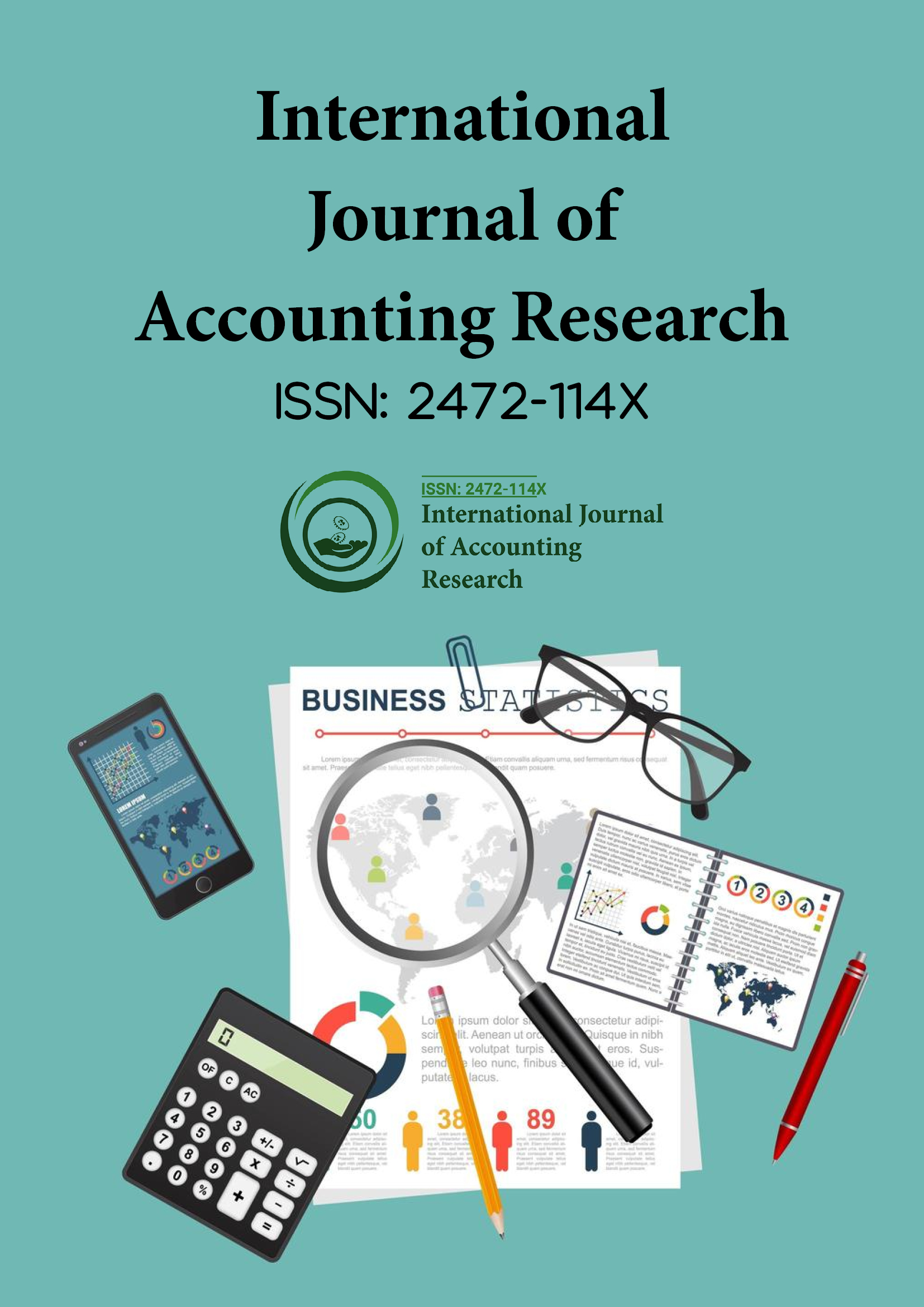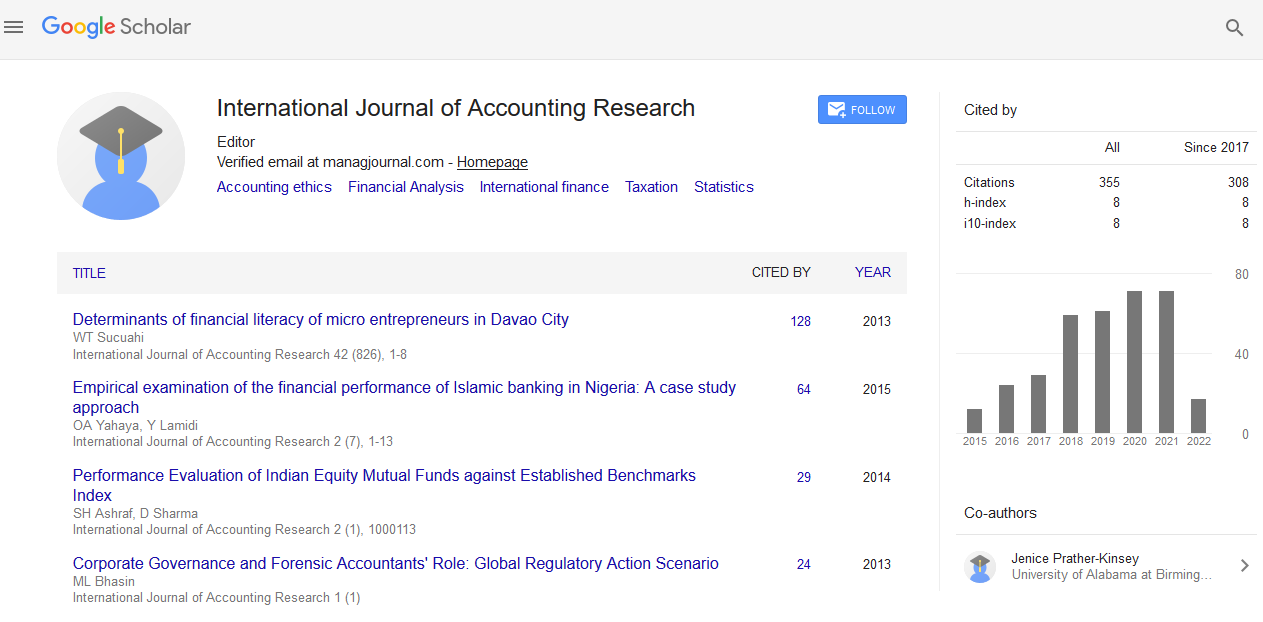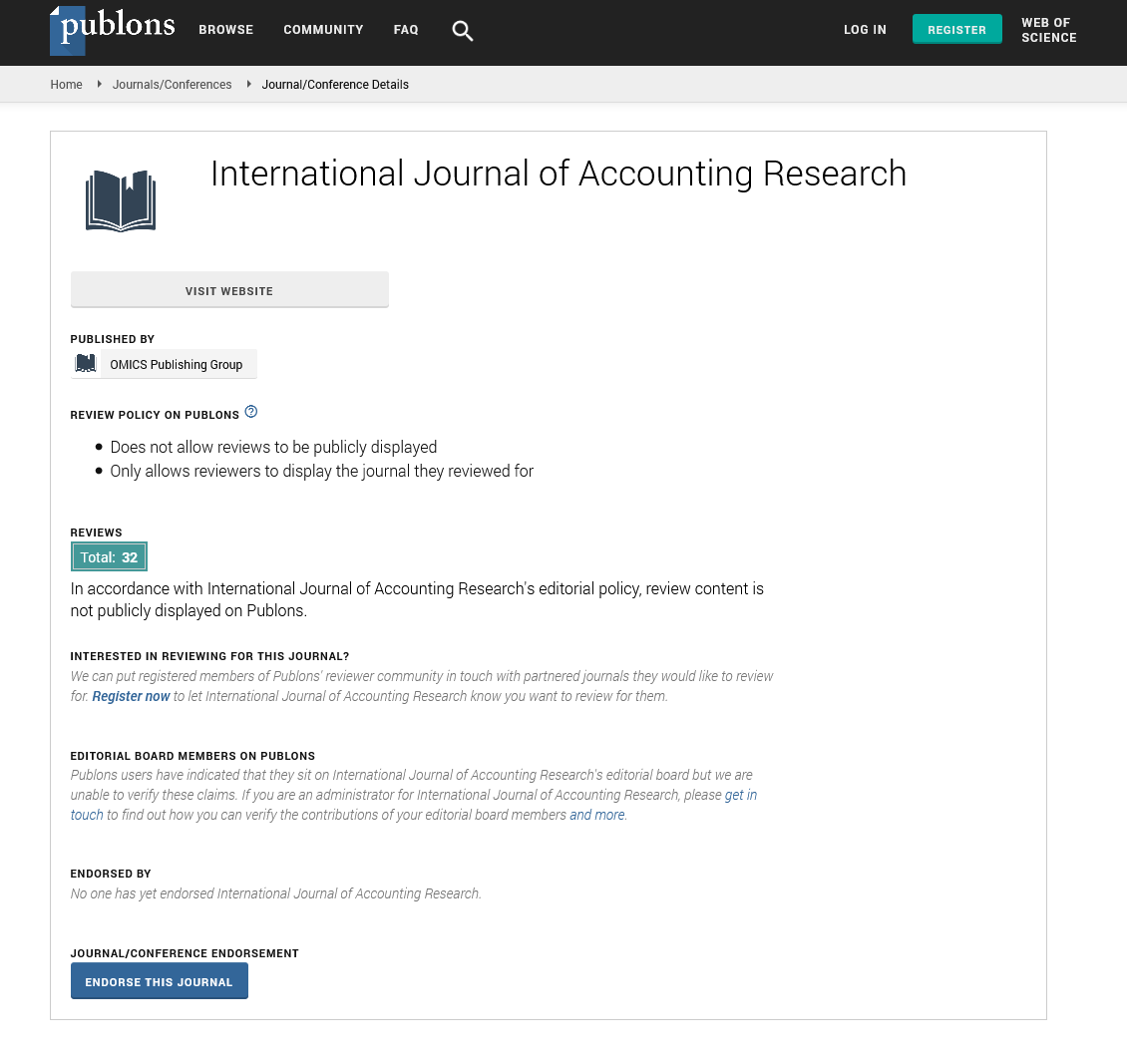Indexed In
- Open J Gate
- RefSeek
- Hamdard University
- EBSCO A-Z
- Scholarsteer
- Publons
- Euro Pub
- Google Scholar
Useful Links
Share This Page
Journal Flyer

Open Access Journals
- Agri and Aquaculture
- Biochemistry
- Bioinformatics & Systems Biology
- Business & Management
- Chemistry
- Clinical Sciences
- Engineering
- Food & Nutrition
- General Science
- Genetics & Molecular Biology
- Immunology & Microbiology
- Medical Sciences
- Neuroscience & Psychology
- Nursing & Health Care
- Pharmaceutical Sciences
Opinion Article - (2022) Volume 10, Issue 8
The Role of Audit Analytics, Efficiency, and Post-Audit Tax
Tommaso Pale*Received: 05-Aug-2022, Manuscript No. IJAR-22-18000; Editor assigned: 08-Aug-2022, Pre QC No. IJAR-22-18000 (PQ); Reviewed: 26-Aug-2022, QC No. IJAR-22-18000; Revised: 01-Sep-2022, Manuscript No. IJAR-22-18000 (R); Published: 08-Sep-2022, DOI: 10.35248/2472-114X.22.10.287
Description
The accounting industry is being impacted by new technologies like data analytics and machine learning. Because of those effects, major changes are expected to audit and assurance methods in particular. Audit sampling is one such potential modification. In the age of big data, it starts to lose some of its meaning. Using audit data analytics is one workable method.
Technologies are developing at an unprecedented rate, presenting businesses and connected parties, including the accounting profession, with both enormous challenges and opportunities. Companies must respond swiftly to shifting circumstances and marketplaces in the current business environment. Many businesses are looking for more effective methods to use new technologies to change the way they do business. In this age of information explosion, new technologies are available that have the power to transform entire industries and business structures. Data is currently one of the most significant assets for many businesses and they a re collect an incredible amount of data as a result of their regular business operations and work to use analytics to fully realize the potential of the data. The accounting industry is also impacted by new technologies including robotic process automation, machine learning, and data analytics. It is crucial for the profession to comprehend the effects, possibilities, and difficulties presented by these technologies.
In order to find potential errors or risks of material misstatement, audit data analytics is defined as "the examination of data underpinning financial statements, coupled with relevant financial or non-financial information." It includes conventional file interrogation, investigative techniques, and statistically supported analytics. But many analytics techniques are new to auditors. Inadequate knowledge and skills are the main obstacles to using data analytics in auditing, according to a new Deloitte poll. Audit data analytics can increase audit efficiency and effectiveness, even if they necessitate more expertise and early investment. Analytics of audit data can help risk evaluations of material misstatements, bankruptcies, and managerial fraud. In their overview of the use of data analytics in external audits, Appelbaum, find that a variety of analytical techniques are frequently used during various engagement phases, including planning/risk assessment, substantive and compliance testing, opinion formulation, and reporting.
In order to establish and maintain compliance, tax audits are a crucial tool, and increasing the number of audits has both direct and indirect effects on taxpayer behavior. The assessment of additional taxes, interest, and penalties to the subjects of audits results in a direct increase in revenue. Tax audits also have unintended consequences since they discourage future noncompliance from both audited and unchecked individuals. There is a growing corpus of research that examines these direct and indirect deterrent effects of tax audits, and it generally demonstrates that more audits result in greater compliance. Whether the specific deterrence effect of enforcement is impacted by audit efficacy, particularly its lack. It is also unclear from the available data whether truly compliant and truly noncompliant taxpayers differ in their behavioral responses to enforcement. A related concern is whether the impact of audits depends on a taxpayer's reporting conduct prior to an audit. When audit efficacy varies, the specific deterrent impact of audits on post-audit tax compliance. As the percentage of undeclared income that the tax authority discovers during an audit and its effects on post-audit compliance, define audit effectiveness.
With field data, it is difficult to determine audit efficacy and how it affects both truly compliant and noncompliant taxpayers. Data from a laboratory experiment, as opposed to field data, enables us to introduce changes in audit effectiveness and likelihood, allowing for clean identification of the causal impacts of these changes on the post-audit compliance of truly complying and truly noncompliant persons. The potential means via which particular deterrent can promote post-audit tax compliance. In addition, our design enables us to examine whether taxpayers' desire to cooperate alters when faced with a compound detection risk as opposed to a decision when an audit results in certain detection.The specific deterrent effect of audits is largely determined by their effectiveness. When an audit finds all unreported income,taxpayers report a bigger portion of their income, but ineffective audits result in lower post-audit compliance. The frequency of audits has no bearing on this effect. Particularly, even after taxpayers have undergone multiple audits, good audits boost post-audit compliance while bad audits have the opposite effect. Particularly, it is recommended that inefficient audits help to offset the deterrent effect of tax audits that has been discovered in some earlier studies. Additionally, taking into account behavioral responses to audit effectiveness as well as recognizing the differences in responses of compliant and noncompliant taxpayers is necessary for a fresh perspective on the tradeoff between audit frequency and audit effectiveness, the analysis of optimal tax administration, and a thorough analysis of a revenue-maximizing audit strategy.
Citation: Pale T (2022) The Role of Audit Analytics, Efficiency, and Post-Audit Tax. Int J Account Res. 10:287.
Copyright: © 2022 Pale T. This is an open-access article distributed under the terms of the Creative Commons Attribution License, which permits unrestricted use, distribution, and reproduction in any medium, provided the original author and source are credited.


